
Balloons have long been synonymous with celebrations, festivities, and joy. Whether they are floating at a child’s birthday party, decorating a wedding venue, or marking the triumph of a sporting event, their cheerful presence has made them essential elements in the world of celebrations. But have you ever thought about where balloons came from and how they transformed into these vibrant symbols of joy? This article delves into the fascinating history of balloons, tracing their evolution from their early origins to their current status as celebration icons.
1. The Early Origins of Balloons
The concept of balloons dates back thousands of years to the early civilizations of South America and the Polynesian islands. In the past, balloons were made from animal bladders, intestines, or skins, which were filled with air or water. The earliest records of these balloon-like objects appear in the 5th century BC when the Greek philosopher Anaxagoras used animal bladders for scientific experiments.
Historically, balloons were often used for practical purposes, such as instruments for scientific measurement or tools for communication and warfare. They gained popularity for their scientific applications in the 18th century: the Montgolfier brothers, Joseph-Michel and Jacques-Étienne, invented the first hot air balloon in 1783, capturing the imaginations of people worldwide.
2. The Evolution of Balloons: From Hot Air to Rubber
After the Montgolfier brothers’ groundbreaking work, balloons evolved from hot air models to easily portable and flexible materials. In the early 19th century, the introduction of rubber revolutionized balloon manufacturing. Charles Goodyear’s discovery of the vulcanization process in the 1840s allowed for the production of stretchy and durable rubber balloons.
These early rubber balloons were not initially intended for parties or celebrations. They were primarily used as playful objects for children and as scientific instruments in laboratories. However, their vibrant colors and ability to hold air or gas eventually led to their adoption as popular party decorations.
3. The Birth of Party Balloons
The transformation of balloons into celebration icons began in the late 19th and early 20th centuries. As industrial manufacturing capabilities improved, balloons became more accessible to the general public.
In the 1930s, balloon makers began producing balloons explicitly designed for parties and celebrations. These balloons were adorned with elaborate prints, designs, and even messages for various occasions. By the 1940s, helium became the gas of choice for inflating balloons, allowing them to float effortlessly, which further enhanced their appeal as decorations for festivities.
4. Balloons in Popular Culture
As balloons gained popularity, they infiltrated popular culture in surprising ways. They began appearing in movies, cartoons, and advertisements, solidifying their place in the collective consciousness as symbols of joy and celebration. Notable moments in film, like the iconic image of balloons tied to a house from the movie “Up,” showcased their whimsical nature and ability to evoke happiness universally.
Balloons also entered the world of artistic expression. Renowned artists like Jeff Koon created stunning works inspired by the playful essence of balloons, leading to the rise of balloon art not only in celebrations but also in fine art galleries.
5. Balloons Today: Celebrations and Beyond
Today, balloons are indispensable in various sectors beyond personal celebrations. They serve critical roles in marketing promotions, grand openings, and community events. Organizations often inflate colorful balloons to create an inviting atmosphere, enhancing their brand visibility.
In the realm of entertainment, balloon artists have carved out niche markets by twisting and shaping balloons into intricate sculptures that amaze audiences of all ages. From balloon animals to elaborate centerpieces, these artists have expanded the possibilities of how balloons can be utilized in entertainment.
Moreover, the use of sustainable materials for balloon manufacturing is gaining traction, reflecting a growing awareness of environmental concerns. Companies are developing biodegradable balloons in response to consumer demand for eco-friendly products, ensuring that the joy balloons bring doesn’t come at the expense of the planet.
6. The Future of Balloons
As we move further into the 21st century, the future of balloons seems bright, combining technology with creativity. Innovations like LED-lit balloons, inflatable structures, and biodegradable materials hint at exciting possibilities. As a go-to decoration for celebrations, balloons will continue resonating with generations to come.
One of the most anticipated advancements is the development of smart balloons equipped with sensors that can interact with people or change colors upon command, merging fun with interactive technology. This evolution could redefine how we celebrate and elevate experiences in parties, weddings, and events.
Conclusion
From their early beginnings serving practical purposes to their current status as beloved symbols of joy and celebration, balloons have undergone an incredible transformation. Their evolution reflects societal changes, technological advancements, and the inherent human desire to celebrate milestones, both big and small. As balloons continue to inspire joy worldwide, their story is a testament to how something as simple as a filled piece of rubber can bring happiness and create lasting memories.








